 March 2013 Tank of the Month
March 2013 Tank of the Month
March 2013 Tank of the Month
Hershel McAlister's (Ocean View) 280 US-gallon Reef Aquarium
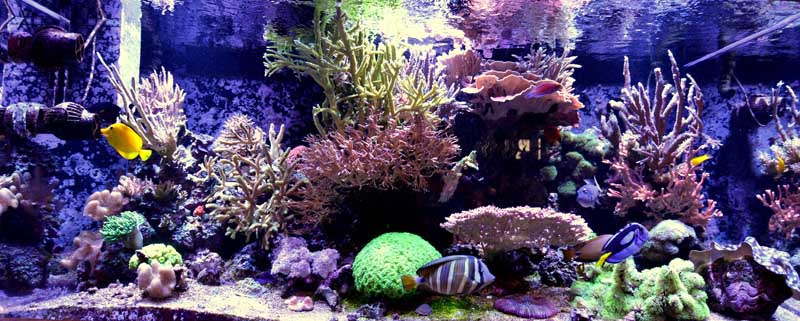 |
Introduction
Well, let me start out by saying, “What an honor!” When I first read the email stating that I had been nominated for the Tank of the Month, I was completely caught off guard. I am not really sure how to describe the feeling, but one thing I know for sure is that if I could bottle and sell this feeling, I would undoubtedly be a very rich person.
Background
As I look back to where I started and how I got to this stage, I have to laugh at how little I knew and the mistakes I have made along the way. I am sure most of you will be able to relate. I have always had an interest in fish and the ocean, and anyone that has visited our home can testify to that. We have a three quarter acre pond behind our house and a 400 gallon indoor atrium pool complete with koi fish. For me, saltwater was the ultimate challenge as well as my dream. Nineteen years ago when my wife and I were building our home, I had envisioned where my saltwater tank would ultimately reside. I never gave up on my dream and it eventually became a reality. My neighbor actually added the push I needed when he offered me his 14 gallon nano tank. That tank, complete with two clown fish and green star polyp stayed in our bedroom for roughly one year.
As we all know, bigger is better when it comes to saltwater tanks - at least that’s what I convinced myself of and more importantly, my wife. So then the real work started; spending hours and hours of researching everything I could about saltwater tanks, fish and corals. This is where my wife thinks I have a tendency to take all the fun out of things, but I disagree. In fact, this is how I got started and became very familiar with Reef Central. I have no idea how many hours I have spend on my hobby, but I do know I am consumed by it and loving every minute of it.
One of my biggest milestones was turning to the large tank section in Reef Central. I’ll never forget that moment. I was reading through all the build forums when I saw a thread where they were moving a large tank into someone’s home. The phone number on the crate caught my eye because it was a local number and at that time I didn’t personally know anybody else that had saltwater tanks other than my neighbor. So I picked up the phone and dialed the number which turned out to belong to Dave aka “Nanook”. I’m sure he has since asked himself several times why he ever answered his phone that day. From that moment on I was constantly calling him and taking in his vast knowledge of saltwater tanks. After seeing his setup, I was hooked and there was no turning back. I was later introduced to John aka “Fade” and he too was more than willing to share his expertise. I just remember thinking, “What a great hobby with so many wonderful people willing to share all that they know”.
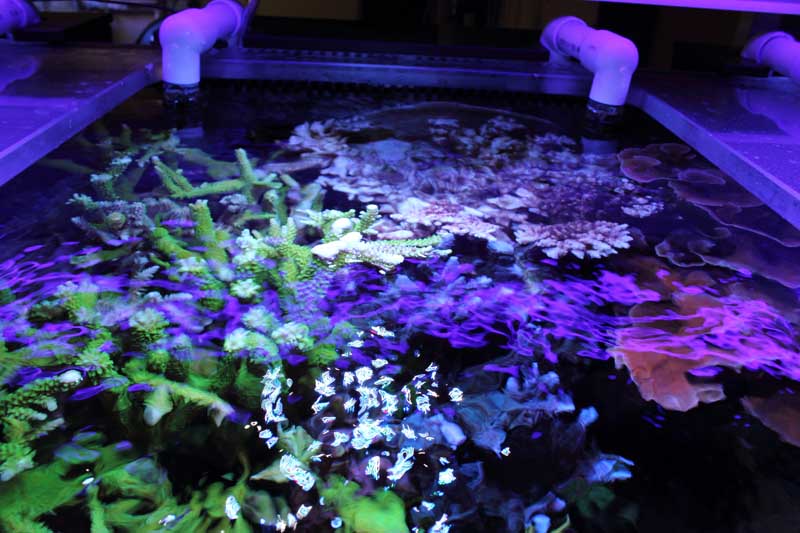 |
Current Tank
I decided on an Acrylic Tank built by Envisions. It’s a 280 gallon 72x30x30 with removable overflows for cleaning and six returns for better water movement. James at Envisions was great to work with. He even sent me pictures of my tank’s progress as it was being built. My only regret was not getting the self-cleaning option at the time I ordered the system. A 72x20x20 Acrylic Sump handles the return water which is pushed around with a 5600 sequence pump. Additional circulation is achieved using three Tunze 6205’s and a Tunze Wavebox. Overkill I know, but from the very beginning the one idea that was constantly drilled into my head was go as large as possible and try not to cut corners. The system has been up for four years now and I’m glad that I followed that advice.
I have three frag tanks tied to the system driven by a Sequence 3200. This pump allows for further expansion as well as supplying water for my calcium reactor, carbon reactor, phosphate reactor, skimmer, and lastly, the kalkwasser reactor. Evaporation is taken care of through two different methods. First, I use a Meter Liter 3 which pumps kalkwsser to the sump. It’s set to pump at a rate less than what’s actually needed to keep up with evaporation. Secondly, I have a Tunze Auto Top Off tied in with a 25 gallon freshwater tank which completes the Top Off. The entire system is controlled using an Aquacontroller, which allows me the ability to check on my tank when I am away from home.
System Profile
• Display tank: 280 Gallon (72in x 30in x 30in)
• Display Lighting: Currently Radion xr30w x3
• Sump: 72in x 30in x 30in
• Return Pump: Sequence 5600 and Sequence 3200
• Calcium Reactor: GEO 818
• Skimmer: H&S with x2 1260 Eheim pumps
• Water Circulation: 6205 Tunze x3 and Tunze Wavebox
• Controller: Neptune Aquacontroller III
• Other: Carbon and phosphate GEO reactors, 5-stage RO/DI Spectrapure water filter, GEO Kalkwasser mixer
 |
Filtration
I’ve tried several different filtration systems from algae scrubbers to refugiums with cheata, but for my system, water changes and live rock seems to work best because of its simplicity, and I’m all about making things as easy as possible. Other attributed of my setup include the sump which is full of live rock and a filter sponge; I do a 10% water change weekly, and the salt is premixed and brought up to the Alk and Mag levels that help maximize growth. In a 150 gallon tank that is being constantly mixed, I use Instant Ocean, so when it’s time to do a water change, a switching of a few valves takes care of the task. This allows me to be in and out in twenty minutes and that includes cleaning the sponge and vacuuming the sump. An H&S 250 skimmer is tied to the system and gets dumped and cleaned daily, whereas, carbon and GFO get changed out monthly.
Supplements
When it comes to supplements, I only use a Kalkwasser and a calcium reactor. As mentioned earlier, the Kalkwasser supplements my top off while reducing the use of my calcium media. My personal feeling is that it also adds to a more stable Ph as well. I have also heard that it helps with the reduction of phosphates, but I have no real evidence to back that up.
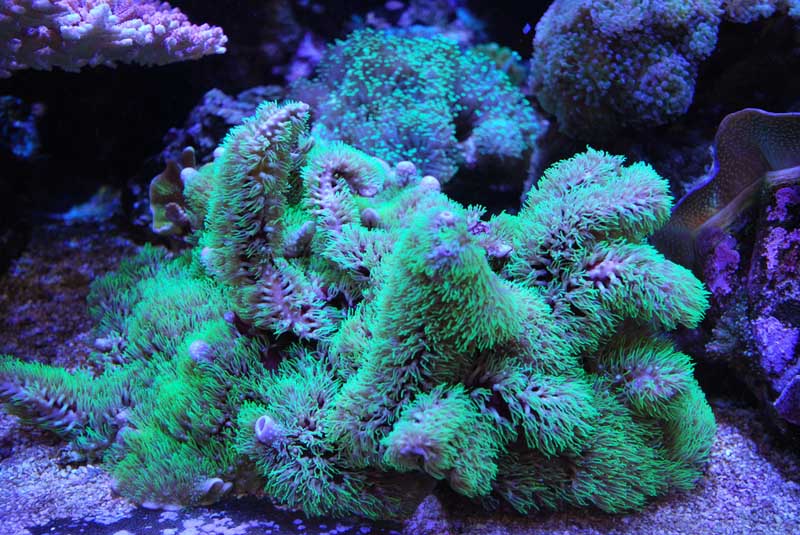 |
Lighting
I started using 250 watt Coralvue electronic ballasts with 12000K Reeflux bulbs. In order to get the spread I was looking for, I went with Lumen Bright Reflectors. I used this system for three years before I switched to Hamilton Pulse Start 400 watt ballasts with Ushio 14,000k bulbs. After using these lights for on year, I decided to try the LEDs because from what I have read it takes less electric, less heat, and has a longer lifespan. I also felt my tank had reached max growth capacity in regards to coral so I chose the Radions because of their software programming ability as well as great customer service. At the time I wrote this article, I had only utilized them on my tank for four months so the verdict is still out as to whether I will continue to use them.
Temperature
I feel the optimum temperature should be between 78.5 and 79.0 degrees. This is accomplished using two 500 watt Finnex heaters in the winter months and a Mitsubishi Mr. Slim A/C in the summer months. The system I started out with for cooling used a chiller but because of the heat it produced as well as the high electric draw, I only utilized this setup for one summer.
Feeding
Feeding is performed once a day and this consists of dry pellets, mysis shrimp, krill, flake food, and nori. I do spot feed some of the corals but for the most part they receive what the fish produce or do not eat.
Maintenance
The tank acrylic is thoroughly cleaned every three to four days. I have found that using a Magic Eraser on the back side of my magnet does a great job of removing most algae and coralline. Alk is checked once per week unless I sense that something is not right. Magnesium is checked once per month, and phosphates and nitrates every other month. The skimmer bowl is emptied and cleaned on a daily basis.
|
Water Parameters:
|
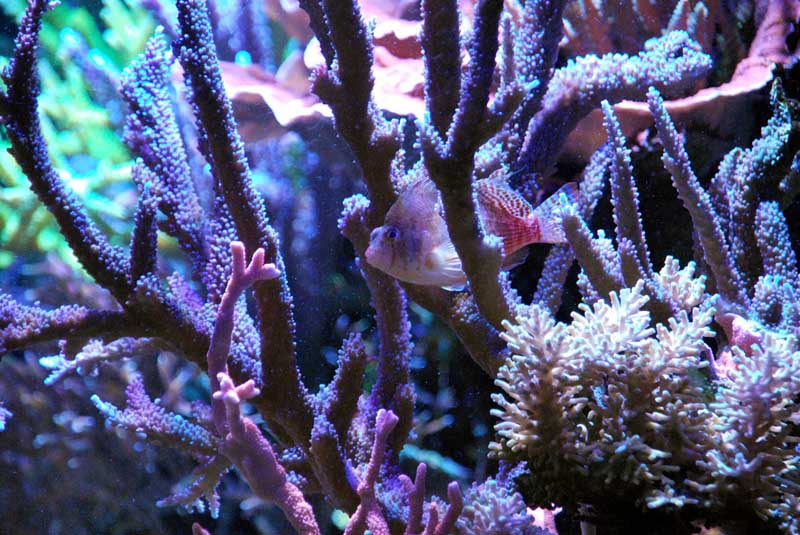 |
Livestock
|
Fish:
|
|
Corals:
|
Final Thoughts
I would like to pass along some knowledge I have acquired over the past several years. One aspect of this hobby that is often overlooked is an alternate power supply. If you lose power to the systems, all of your hard work could go down the drain. A backup generator fills this role nicely. When it comes time to make changes to your tank, make them gradually. Enthusiasm in a new endeavor often surpasses our endurance to keep it going. To counter this effect simplicity in the setup is key. I found that setting the system up to run as automatic as possible keeps it from becoming overwhelming. Lastly, learn to enjoy the beauty and serenity of your tank when you look at it or you’ll forget the reason you started the hobby in the first place.
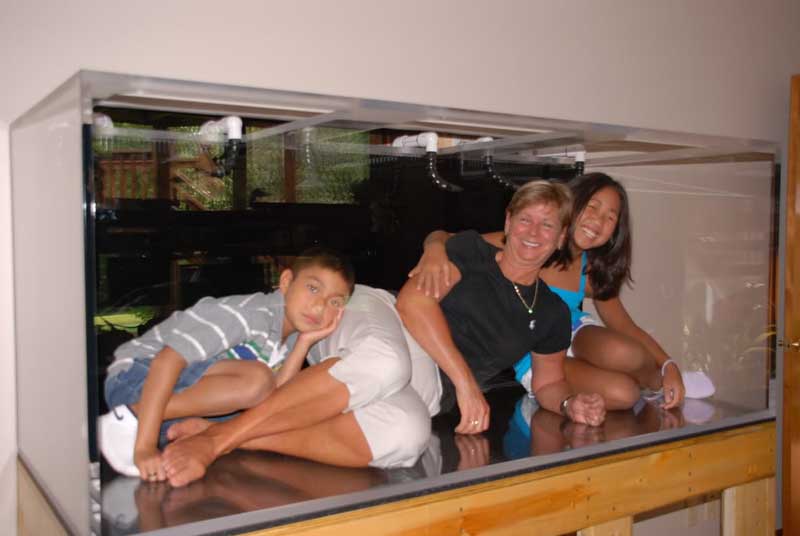 |
Acknowledgment
I’d like to thank my wife and family for their endless support in this hobby. Not only do they feed my fish and clean the tanks when I’m away, but when I call wanting something checked on they don’t complain. My neighbor Kim is also very willing to come over and care for or fish when we are out of town. My local club members have always helped keep my interest up when it would have been very easy to lose interest. I’d like to also thank Curt aka “Smoothdog” and Daniel aka “Twiggyb” for taking the pictures. And of course, thanks to Reef Central. The knowledge that this forum has provided has been priceless.
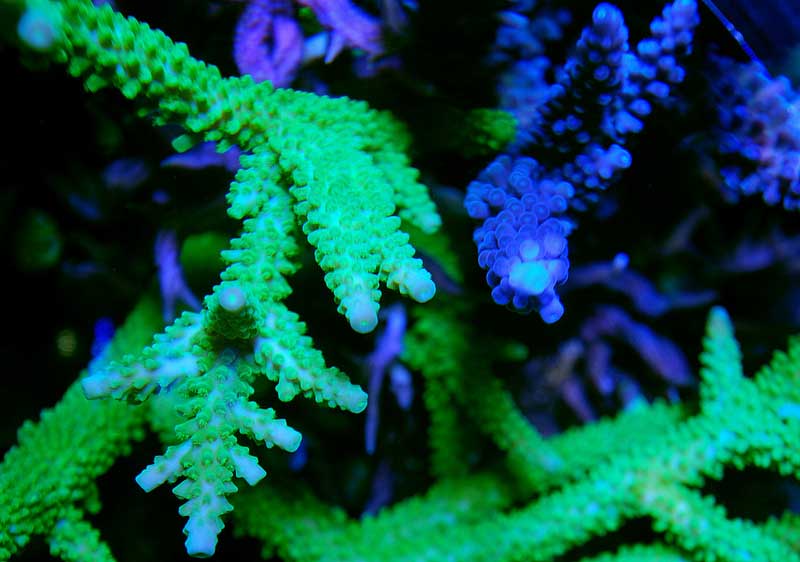 |
Feel free to comment or ask questions about my tank in the Tank of the Month thread on Reef Central.



